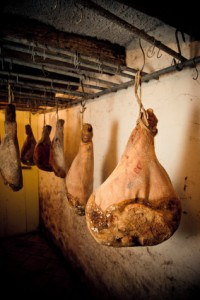If you haven’t considered what would happen without power, start by looking in your kitchen. Your refrigerator would no longer work. Meats and perishables would spoil quickly. While we all want to think we won’t ever be without electricity, no one can predict when the next major world war or other catastrophe will occur.
A major catastrophe that shuts down power plants would be devastating—that is, unless you are prepared and know how to survive. You should learn how to preserve meat without refrigeration. Salting and brining are two efficient, simple means of preserving meat for your family’s sustenance.
 Before You Start
Before You Start
You are going to need a source of fresh meat. Beef and pork are both good options. If you have gotten into homesteading, you may have your own pigs and cows; however, you can also purchase fresh meat from a butcher or a co-op that sells beef and pork fresh off the hoof.
Next, you should examine your house thoroughly using a thermometer. As you go from one area to the next, record the temperature. Make sure you check the attic, any unheated areas of your house, your storage shed, and any other shelters on your property. You are looking for the coldest areas; this is where you will store your meat.
Salting Pork for Preservation
Many people have forgotten this old method of preserving pork. It is one of the easiest methods available and doesn’t take much time. You will need fresh pork, pickling salt, brown sugar, and crocks or jars for storage.
First, cut the pork into slabs. Generally, four- to six-inch slabs work best. Mix 1/2 pound of pickling salt with 1/4 cup of brown sugar. This is enough to cover twelve pounds of pork. Liberally cover the pork with this mixture. Next, pack the meat into sterilized crocks or jars. You should make sure it is tightly packed. Cover the meat with cheesecloth.
Using the temperature chart of your house, determine where to store your crocks. You need to keep the meat in an area that is about 36°F – no higher than 38°F. You also do not want an area that could see freezing temperatures. Leave the meat in this cool storage for at least one month. After that time, you can wrap the meat in plastic or moisture-proof paper and leave it stored all winter. You now have salt-cured pork for any occasion.
Many older people remember having a smokehouse on their land when they were young. Meat would be salted and hung to cure in these cool, dry areas. You could build a storage room for handing meat without too much work. The room should have excellent air circulation and stay cool without freezing.
Brining Pork
Brining is a reliable method of preserving pork, although it takes a little more time than salt preserving. Start out the same way you do for salt preserving by cutting the fresh pork into slabs. Next, you need to pack the pork into a sterilized container like a crock or jar.
Dissolve 1 pound of pickling salt and 1/2 cup of brown sugar in 3 quarts of water. Pour this brine over the pork and ensure that the meat is completely covered in liquid. If you have a problem covering the meat completely in brine, add a weight to the meat to keep it submerged. A plate with something heavy on top will work nicely. Store the covered pork in one of your rooms that will stay an average temperature of 36°F.
Time-tested advice on how to cure the meat by smoking or salting helps you preserve your harvest.
After the first week, remove the pork from the brine. Stir the brine well and repack the meat. Leave in the cool room and repeat this process for the next four weeks. If the brine is thick or stringy on any of the weeks you open it, remove the meat. Empty the brine and sterilize the crocks. Wash each piece of pork well before repacking. Mix a fresh batch of brine for the meat, and put back into storage. At the end of four weeks, your meat is ready to be cooked.
Canned Meat
If you are familiar with canning fruits and vegetables, you should know that you can also can meat. You have to make sure you get the temperature of the meat high enough to kill bacteria before it seals. Chicken and beef are good options for canning, as are fish. You can cook the meat before you can and seal it. For example, you could make beef stew and preserve it in cans. Stewed chicken also cans and preserves well. Raw packing is another option you can try as well.
Dehydration
While most of us tend to think of jerky as a snack food, dried meat is another viable option for preserving meat without using refrigeration. Although you’d probably have trouble rehydrating enough meat to prepare a Sunday roast dinner, you could definitely use jerky that has been broken into small pieces as a welcome addition to soups, stews, and chilis. Beef, pork, venison, and turkey all make excellent jerkies.
Live Animals
If you are trying to get back to the basics of homesteading and want to be prepared for any emergency situation, you may want to consider having some live sources of protein. You can easily raise rabbits and chickens. A small pond can be stocked with fish. If you have room, you can add a dairy cow for milk and a bull to slaughter. However, once you slaughter the bull, you will need to cure some of the meat so that it doesn’t all go bad.
Part of getting back to the basics involves knowing how to hunt animals for food. Venison is an excellent meat, and deer can be found that are small enough to provide you with plenty of meat without the need to preserve large amounts of meat for long periods of time.
No one wants to think about losing electricity and all the luxuries that it brings. However, nothing is promised, and it wouldn’t take much to shut down electricity. You don’t want to be one of the people who are not prepared for basic survival.
Preparing your family for catastrophe doesn’t mean you have to stop living with your refrigerator. However, it does mean knowing what to do in the event you don’t have a refrigerator. Additionally, knowing how to preserve meat can save you money by raising and preserving some of your own meat. Put the tips here to use and ensure you know how to keep meat from spoiling.
©2012 Off the Grid News
 Off The Grid News Better Ideas For Off The Grid Living
Off The Grid News Better Ideas For Off The Grid Living




